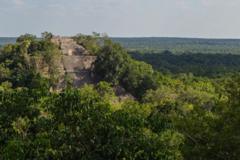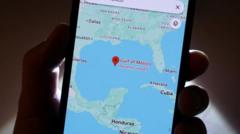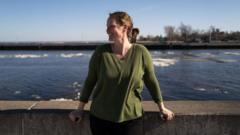Researchers uncover the sprawling Valeriana, adding depth to Mayan history and civilization complexity.
### Lost Mayan City Unearthed in Mexican Jungle by Accident

### Lost Mayan City Unearthed in Mexican Jungle by Accident
A serendipitous discovery reshapes understanding of ancient civilizations in the Tropics.
A remarkable archaeological revelation has emerged from the jungles of Mexico, where researchers stumbled upon a vast Mayan city, now named Valeriana, that had been lost for centuries beneath dense canopies. This extraordinary find, located in the southeastern state of Campeche, consists of monumental structures including pyramid temples, sports fields, and a network of causeways connecting different districts.
The discovery, facilitated by laser imaging detection and ranging (LiDAR) technology, revealed a complex believed to rival Calakmul, long considered the largest Mayan site in ancient Latin America. Valeriana covers an area comparable to the city of Edinburgh and is estimated to have housed between 30,000 and 50,000 inhabitants during its peak in the 8th to 9th centuries.
The archaeological breakthrough occurred quite by accident when Luke Auld-Thomas, a PhD student from Tulane University, unexpectedly discovered a radar survey during an internet search. “I was on something like page 16 of Google search and found a radar survey done by a Mexican organization for environmental monitoring,” he explained. Upon analyzing the data using techniques common in archaeology, Auld-Thomas recognized the significance of what appeared to be an ancient urban center.
The Valeriana site challenges long-held notions in Western scholarship that equated the tropical zones with the decline of civilizations. Professor Marcello Canuto, a co-author of the research, emphasized that this region of the world housed rich and dynamic cultures. While the precise reasons for the city’s eventual abandonment remain uncertain, researchers note that climate change played a significant role.
Geographically, Valeriana is easily accessible, situated just a 15-minute walk from a main road near Xhipul, where a modern Mayan community resides. Despite the positive findings, local knowledge of the site remained largely unrecognized, and no photographic evidence was available prior to the discovery as “no one has ever been there,” according to researchers.
The city, spanning approximately 16.6 square kilometers, featured two major centers of activity separated by 2 kilometers and interconnected by an array of residential buildings and causeways. Auld-Thomas and his team identified two plazas adorned with temple pyramids, spaces where sacred rituals and ceremonies may have occurred, along with a ball court indicative of ancient sporting activities.
The research team also noted evidence of a reservoir, highlighting the sophisticated methods that the Mayans employed to sustain a large population. Analysis of the site uncovered a staggering total of 6,764 recognizable structures, showcasing the extent of past habitation in the tropical landscape.
Supporting this new perspective, Professor Elizabeth Graham from University College London stated that the evidence reinforces the notion that the Mayans resided in complex urban centers rather than isolated villages. “The point is that the landscape is definitely settled – that is, settled in the past – and not, as it appears to the naked eye, uninhabited or ‘wild’,” she articulated.
Subsequent research suggests that as Mayan civilizations began to decline around 800 AD, factors including dense populations and inability to adapt to climatic changes contributed to their collapse. The intertwining of warfare and the Spanish conquest in the 16th century further complicated the landscape, leading to the eradication of numerous Mayan city-states.
LiDAR technology has transformed archaeological methods, enabling researchers to uncover countless lost civilizations hidden under vegetation. Professor Canuto indicated that LiDAR has allowed for the mapping of ten times the area compared to traditional archaeological methods conducted over the last century.
Mr. Auld-Thomas anticipates the potential discovery of many more uncharted sites, acknowledging the overwhelming number of new Maya cities unearthed since LiDAR's introduction. “There are more sites out there than we can ever hope to study,” he admitted. The findings were detailed in the academic journal Antiquity, marking a significant advancement in our understanding of ancient Mayan societies and their resilience amidst environmental challenges.
The discovery, facilitated by laser imaging detection and ranging (LiDAR) technology, revealed a complex believed to rival Calakmul, long considered the largest Mayan site in ancient Latin America. Valeriana covers an area comparable to the city of Edinburgh and is estimated to have housed between 30,000 and 50,000 inhabitants during its peak in the 8th to 9th centuries.
The archaeological breakthrough occurred quite by accident when Luke Auld-Thomas, a PhD student from Tulane University, unexpectedly discovered a radar survey during an internet search. “I was on something like page 16 of Google search and found a radar survey done by a Mexican organization for environmental monitoring,” he explained. Upon analyzing the data using techniques common in archaeology, Auld-Thomas recognized the significance of what appeared to be an ancient urban center.
The Valeriana site challenges long-held notions in Western scholarship that equated the tropical zones with the decline of civilizations. Professor Marcello Canuto, a co-author of the research, emphasized that this region of the world housed rich and dynamic cultures. While the precise reasons for the city’s eventual abandonment remain uncertain, researchers note that climate change played a significant role.
Geographically, Valeriana is easily accessible, situated just a 15-minute walk from a main road near Xhipul, where a modern Mayan community resides. Despite the positive findings, local knowledge of the site remained largely unrecognized, and no photographic evidence was available prior to the discovery as “no one has ever been there,” according to researchers.
The city, spanning approximately 16.6 square kilometers, featured two major centers of activity separated by 2 kilometers and interconnected by an array of residential buildings and causeways. Auld-Thomas and his team identified two plazas adorned with temple pyramids, spaces where sacred rituals and ceremonies may have occurred, along with a ball court indicative of ancient sporting activities.
The research team also noted evidence of a reservoir, highlighting the sophisticated methods that the Mayans employed to sustain a large population. Analysis of the site uncovered a staggering total of 6,764 recognizable structures, showcasing the extent of past habitation in the tropical landscape.
Supporting this new perspective, Professor Elizabeth Graham from University College London stated that the evidence reinforces the notion that the Mayans resided in complex urban centers rather than isolated villages. “The point is that the landscape is definitely settled – that is, settled in the past – and not, as it appears to the naked eye, uninhabited or ‘wild’,” she articulated.
Subsequent research suggests that as Mayan civilizations began to decline around 800 AD, factors including dense populations and inability to adapt to climatic changes contributed to their collapse. The intertwining of warfare and the Spanish conquest in the 16th century further complicated the landscape, leading to the eradication of numerous Mayan city-states.
LiDAR technology has transformed archaeological methods, enabling researchers to uncover countless lost civilizations hidden under vegetation. Professor Canuto indicated that LiDAR has allowed for the mapping of ten times the area compared to traditional archaeological methods conducted over the last century.
Mr. Auld-Thomas anticipates the potential discovery of many more uncharted sites, acknowledging the overwhelming number of new Maya cities unearthed since LiDAR's introduction. “There are more sites out there than we can ever hope to study,” he admitted. The findings were detailed in the academic journal Antiquity, marking a significant advancement in our understanding of ancient Mayan societies and their resilience amidst environmental challenges.






















